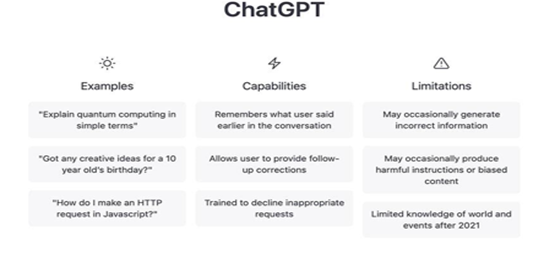Context
- Recently, ChatGPT, the artificial intelligence (AI)-powered chatbot crossed one million users in less than a week since it was officially made available to the public.
- The article explains the meaning, significance and limitations of this new development.
About ChatGPT

- ChatGPT is language-generation software that’s been designed to carry conversations with people.
- The tool has been developed by OpenAI, a research institute founded in 2015, by a group of entrepreneurs and researchers, including Elon Musk, Sam Altman, and Greg Brockman.
- The company is best known for Dall-E — the AI-based text-to-image generator
- It is based on the company’s GPT 3.5 series of language learning models (LLM).
- GPT stands for Generative Pre-trained Transformer 3 and this is a kind of computer language model that relies on deep learning techniques to produce human-like text based on inputs.
- Some of its features include the following:
- Answering follow-up questions
- Challenging incorrect premises
- Rejecting inappropriate queries and even admitting its mistakes, etc.
- It is trained on an enormous amount of text data (from archived books, Wikipedia, etc.) and learned to recognize patterns that enable it to produce its own text mimicking various writing styles.
- It is a part of the larger generative AI, which refers to the ability of computers to automatically create text, videos, photos and other media using cutting-edge machine learning technologies.
- This chatbot powered by AI, makes use of Reinforcement Learning from Human Feedback (RLHF) technology.
- This technology produces different answers for the same question in the future since it improves over time and understands queries better through machine learning.
Language-generation software
- It is a software that generates a sequence of words as output that are conceptually connected to the words given as input.
- In practical terms, it means that it can perform tasks like answering questions and carrying on a conversation with humans.
- It is often used in natural language processing (NLP) applications, such as speech recognition, automatic translation, and text generation.
- There are a few other language models like BERT (Bidirectional Encoder Representations from Transformers), LaMDA (Language Model for Dialogue Applications) from Google.
Natural language processing (NLP)
- A component of AI, NLP is the ability of a computer program to understand human language as it is spoken and written, referred to as natural language.
- There are two main phases to natural language processing as follows:
- Data preprocessing: It involves preparing and "cleaning" text data for machines to be able to analyze it.
- Algorithm development: Once the data has been preprocessed, an algorithm is developed using linguistic rules and statistical methods through repeated processing and learning.
Significance of ChatGPT
- ChatGPT’s ability to learn and adapt quickly to new information means that it can be trained to handle new topics and tasks without the need for extensive retraining.
- Many experts believe that ChatGPT’s advanced capabilities will be a valuable asset for companies in fields such as customer service, online education, and market research.
- It can respond to a large range of questions while imitating human speaking styles, e.g., answering customer service queries, help debug a code, etc.
- It is being seen as a replacement for the basic emails, party planning lists, CVs, and even college essays and homework.
- It can also do creative tasks such as writing a story and can explain scientific concepts and answer any question that needs factual answers.
- ChatGPT is much more than a chat bot. For example, it can be asked to write a program or even a simple software application.
- It is also capable of reviewing and writing codes in seconds, making the future of coders grim.
- ChatGPT has also been trained to decline ‘inappropriate’ requests, presumably those which are ‘illegal’ in nature.
Limitations of ChatGPT
- The ChatGPT displayed racial and sexist biases, which remains a problem with almost all AI models.
- Though it gives grammatically correct and read well answers but few users have pointed out that these lack context and substance and are more generalized.
- It also overuses certain phrases due to biases in the training data.
- It also occasionally produces inaccurate information and that its knowledge is restricted to global events that occurred before 2021.
- It is also unable to provide answers to country-specific questions.
Conclusion
- So far, the response to ChatGPT has been overwhelmingly positive, with many praising its advanced capabilities and ease of use.
- It remains to be seen how ChatGPT will be used in the coming years, but it’s clear that it has the potential to be a major player in the world of natural language processing.









